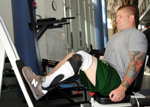A new energy-storing AFO along with an extensive rehabilitation program is allowing wounded warriors who previously had difficulties walking or standing due to lower-leg injuries to run again. The Intrepid Dynamic Exoskeletal Orthosis (IDEO) was designed by Ryan Blanck, CPO, at the Center for the Intrepid (CFI), Fort Sam Houston, Texas. It is a custom-fit device made from carbon and fiberglass that supports the foot and ankle and resembles a running prosthesis.

Spc. Michael Krapels, a member of the Chosen Company, 2nd Battalion, 503rd Infantry Regiment, works to strengthen his leg while wearing an Intrepid Dynamic Exoskeletal Orthosis during physical therapy at the Center for the Intrepid. Photograph courtesy of Steven Galvan, U. S. Army Medicine.
Advances in surgical techniques enable Lt. Col. Joseph Hsu, MD, an orthopedic surgeon at the U.S. Army’s Institute of Surgical Research, to save legs once previously destined for amputation. During the healing process, rehabilitation for each wounded soldier is designed to try and get them back to pre-injury condition.
The ability to run can determine whether wounded warriors are allowed to stay on active duty and return to their units after having been considered for a medical discharge from the military. Some can rehabilitate for months, even years, and may never gain full flexibility or capabilities. This lack of progress can be so discouraging that some wounded soldiers have requested an amputation, and while it can be an option, it is a lengthy process that involves extensive counseling. Due to these requests, Johnny Owens, MPT, a physical therapist at the CFI, Blanck, and Hsu collaborated, under Hsu’s guidance, to combine the critical surgical, orthotic design, and rehabilitation processes into one process.
Owens tailors a rehabilitation program for each warrior according to their injuries. A rehabilitation program aimed at getting wounded soldiers running is called “Return to Run.” According to Owens, this multidisciplinary program is built around an aggressive rehabilitation plan. “Patients needing support to their lower legs can be fitted with the IDEO,” Owens said. “This enables them the ability to return to running, sports, and military deployments.
The IDEO is custom-made using a mold from the warrior’s leg. The three-piece device fits in shoes and boots. The top piece that is placed just below the knee is shaped like the top portion of a prosthetic leg. Both pieces are held together by a sturdy and flexible support bar. The upper and lower sections are joined by a carbon-fiber, dynamic-response strut system originating from prosthetic technology used with the high-activity amputee population within the Department of Defense (DOD).
“The way it works is very much like a runner’s prosthetic,” Blanck said. “As the warrior steps on it and moves forward, the energy of the foot piece is transferred to the back of the foot piece with a spring motion.”
In order to maximize the full benefits of the IDEO, users go through extensive rehabilitation sessions. During the initial sessions, they are trained on how to step with the device. As they progress through the rehabilitation, users are introduced to more stringent training that involves running and jumping up and down and side to side. Then weights are introduced.
“They have to get used it to and learn how it works,” Owens said. “Once they feel comfortable with the IDEO, we encourage them to push themselves without overdoing it.”
Since its inception, 143 wounded warriors have been fitted with the IDEO. The majority of its recipients are in combat arms specialty jobs like the Navy SEALs and Army Rangers. The IDEO is allowing these warriors to run, parachute, and perform demanding physical activities required from these Special Forces members.
“After a couple of years of using one, I had a soldier who didn’t need it anymore,” said Owens. “The IDEO helped him regain full use of his leg and [he] no longer requires it.”




